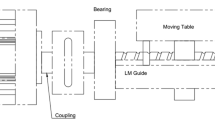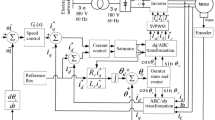Abstract
The latest development trend of direct-drive electro-hydraulic servo technology is discussed. The working principle, system model and system control theory of an electro-hydraulic servo system are studied. The dynamic behavior of the direct-drive electro-hydraulic servo system is highly nonlinear, structure uncertainty. Considering that the standard PID controller cannot fulfill all the demands, it is necessary to use advanced means for compensation. A PID controller optimized by genetic algorithm for an electro-hydraulic servo system direct driven by a permanent magnet synchronous motor is proposed. The genetic algorithm is applied to optimize the parameters of the PID controller. The simulation and experiment research of one direct-drive electro-hydraulic servo system are carried out to verify the response properties of the proposed controller. The step signal tracking responses of the servo system with different parameters of PID controller are, respectively, reported. In addition, a feedforward PID controller using genetic algorithm optimization is also designed for the direct-drive servo system. The simulation and experiment results show that the feedforward PID controller using genetic algorithm optimization has good dynamic response characteristics in the electro-hydraulic servo system based on a direct-drive permanent magnet synchronous motor.





Similar content being viewed by others
References
Zheng S, Tang X, Song B (2016) Tuning strategy of fractional-order proportional integral controllers for permanent magnet synchronous motor servo system based on enhanced stochastic multi-parameters divergence-based optimisation algorithm. IET Control Theory Appl 10(11):1240–1249. https://doi.org/10.1049/iet-cta.2015.0922
Lu T, Cheng G (2016) Expanded proximate time-optimal servo control of permanent magnet synchronous motor. Optim Control Appl Methods 37(4):782–797
Yu W, Luo Y, Chen Y et al (2016) Frequency domain modelling and control of fractional-order system for permanent magnet synchronous motor velocity servo system. Control Theory Appl Iet 10(2):136–143. https://doi.org/10.1049/iet-cta.2014.1296
Lin FJ, Sun IF, Yang KJ et al (2016) Recurrent fuzzy neural cerebellar model articulation network fault-tolerant control of six-phase permanent magnet synchronous motor position servo drive. IEEE Trans Fuzzy Syst 24(1):153–167. https://doi.org/10.1109/TFUZZ.2015.2446535
Liu J, Hong-Wen LI, Deng YT (2017) Current adaptive sliding mode control based on disturbance observer for permanent magnet synchronous motor. Opt Precis Eng 25(5):1229–1241
Tharwat A, Mahdi H, Elhoseny Mohamed, Hassanien AE (2018) Recognizing human activity in mobile crowdsensing environment using optimized k-NN algorithm. Expert Syst Appl 107:32–44. https://doi.org/10.1016/j.eswa.2018.04.017
Niu X, Zhang C, Li H (2017) Active disturbance attenuation control for permanent magnet synchronous motor via feedback domination and disturbance observer. IET Control Theory Appl 11(6):807–815. https://doi.org/10.1049/iet-cta.2016.1429
Metawaa N, Hassana MK, Elhoseny M (2017) Genetic algorithm based model for optimizing bank lending decisions. Expert Syst Appl 80:75–82. https://doi.org/10.1016/j.eswa.2017.03.021
Zheng Z, Huang T, Zhang H et al (2016) Towards a resource migration method in cloud computing based on node failure rule. J Intell Fuzzy Syst 31(5):2611–2618. https://doi.org/10.3233/JIFS-169101
Chahal M, Harit S, Mishra KK, Sangaiah AK, Zheng Z (2017) A survey on software-defined networking in vehicular ad hoc networks: challenges, applications and use cases. Sustain Cities Soc 35(11):830–840. https://doi.org/10.1016/j.scs.2017.07.007
Rizk-Allah RM, Hassanien AE, Elhoseny M (2018) A multi-objective transportation model under neutrosophic environment. Comput Electr Eng Elsevier. (in press). https://doi.org/10.1016/j.compeleceng.2018.02.024
El Aziz MA, Hemdan AM, et al. (2017). Prediction of biochar yield using adaptive neuro-fuzzy inference system with particle swarm optimization. In: 2017 IEEE PES power Africa conference, June 27–30, Accra-Ghana. https://doi.org/10.1109/PowerAfrica.2017.7991209
Elhoseny M, Yuan X, et al. (2014) Extending self-organizing network availability using genetic algorithm. In: 2014 international conference on computing, communication and networking technologies (ICCCNT), July 11–13, Hefei-China. https://doi.org/10.1109/ICCCNT.2014.6963059
Ekanayake S, Dutta R, Rahman MF et al (2018) Direct torque and flux control of interior permanent magnet synchronous machine in deep flux-weakening region. IET Electr Power Appl 12(1):98–105. https://doi.org/10.1049/iet-epa.2017.0147
Author information
Authors and Affiliations
Corresponding author
Ethics declarations
Conflict of interest
The authors declare that they have no conflict of interest.
Rights and permissions
About this article
Cite this article
Cao, F. PID controller optimized by genetic algorithm for direct-drive servo system. Neural Comput & Applic 32, 23–30 (2020). https://doi.org/10.1007/s00521-018-3739-z
Received:
Accepted:
Published:
Issue Date:
DOI: https://doi.org/10.1007/s00521-018-3739-z




